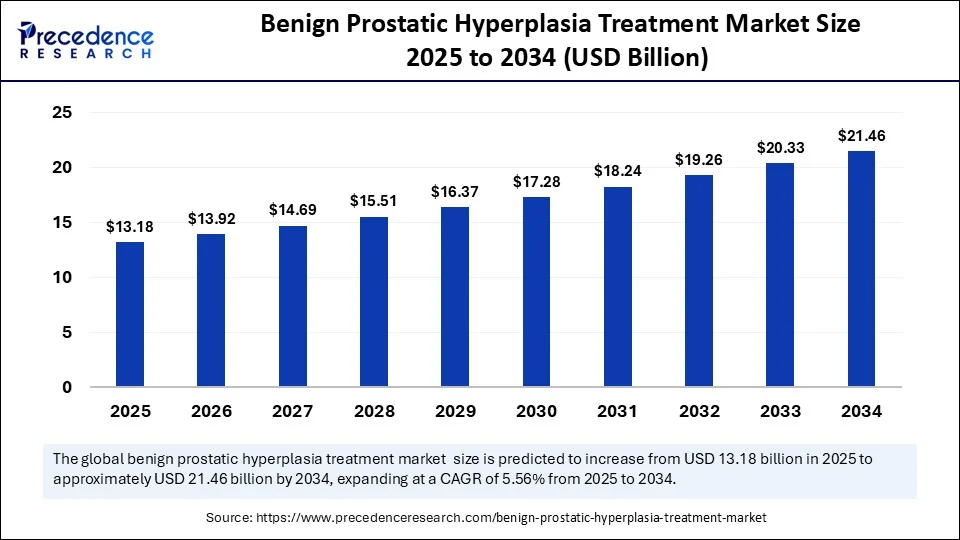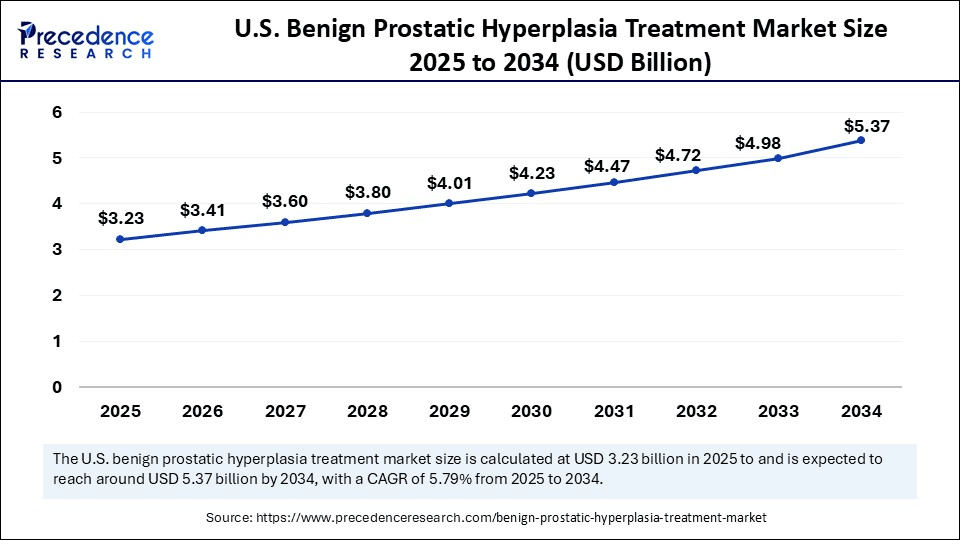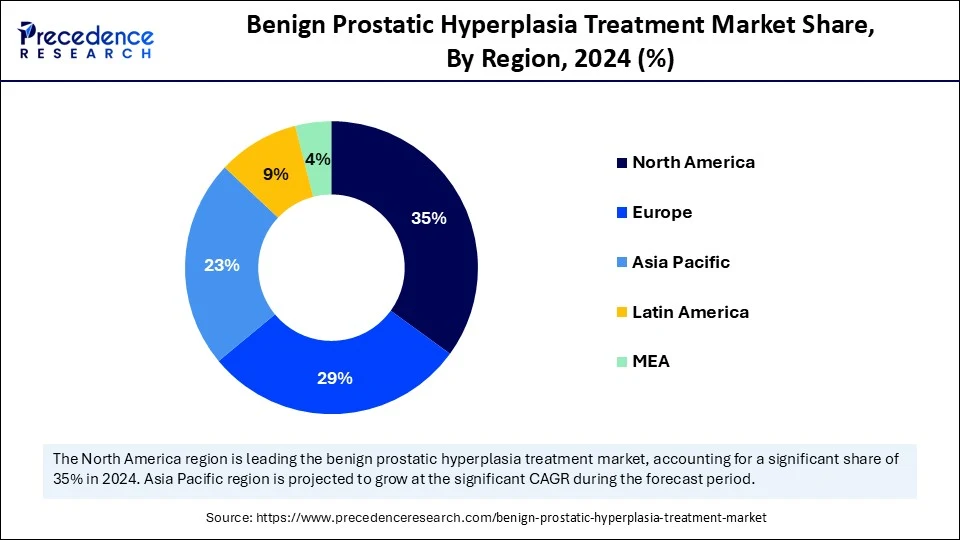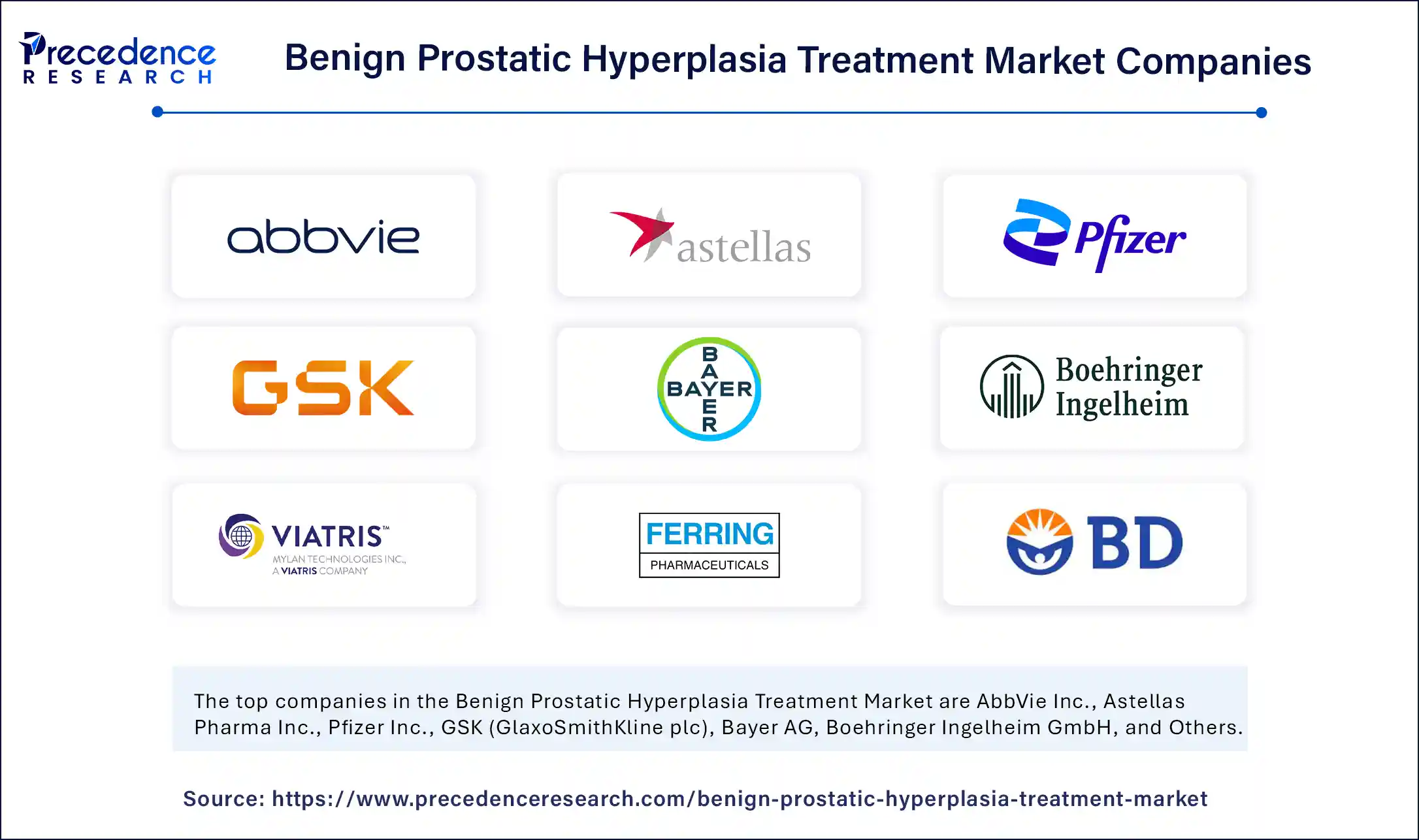Benign Prostatic Hyperplasia Treatment Market Size and Forecast 2025 to 2034
The global benign prostatic hyperplasia treatment market size accounted for USD 12.49 billion in 2024 and is predicted to increase from USD 13.18 billion in 2025 to approximately USD 21.46 billion by 2034, expanding at a CAGR of 5.56% from 2025 to 2034.The growth of the benign prostatic hyperplasia treatment market is driven by increasing geriatric population, greater understanding of urological health, high demand for less invasive procedures, and the availability of effective medications.

Benign Prostatic Hyperplasia Treatment MarketKey Takeaways
- In terms of revenue, the global benign prostatic hyperplasia treatment market was valued at USD 12.49 billion in 2024.
- It is projected to reach USD 21.46 billion by 2034.
- The market is expected to grow at a CAGR of 5.56% from 2025 to 2034.
- North America dominated the benign prostatic hyperplasia treatment market with the largest market share of 35% in 2024.
- Asia Pacific is expected to witness the fastest growth during the forecast years.
- By treatment type, the alpha-blockers segment captured the biggest market share of 28% in 2024.
- By treatment type, the minimally invasive procedures segment is anticipated to show considerable growth over the forecast period.
- By end user, the hospitals segment contributed the highest market share of 65% in 2024.
- By end user, the ambulatory surgical centres segment is expected to show considerable growth over the forecast period.
- By patient age group, the above 60 years segment held the major market share of 55% in 2024.
- By patient age group, the 58.50-year-old segment is anticipated to show considerable growth in the market over the forecast period.
- By distribution channel, the hospital pharmacy segment accounted for significant share of 60% in 2024.
- By distribution channel, the online pharmacy segment is anticipated to show considerable growth over the forecast period.
How is AI Revolutionizing the Diagnosis and Treatment of BPH?
Artificial intelligence integration in the benign prostatic hyperplasia treatment market is expected to aid in enhancing the level of diagnosis accuracy, treatment planning, and patient outcomes. AI-powered tools enhance prostate imaging and urinary stream analysis for early detection and severity assessment. AI helps tailor therapies based on individual patient conditions. AI algorithms can analyze medical images, such as MRI and ultrasound, to detect and assess the severity of BPH more accurately and efficiently than traditional methods. This can lead to earlier and more precise diagnoses. Moreover, AI accelerate the process of identifying and developing new drugs for BPH by analyzing vast datasets of biological information and predicting drug efficacy.
U.S. Benign Prostatic Hyperplasia Treatment Market Size and Growth 2025 to 2034
The U.S. benign prostatic hyperplasia treatment market size was exhibited at USD 3.06 billion in 2024 and is projected to be worth around USD 5.37 billion by 2034, growing at a CAGR of 5.79% from 2025 to 2034.

Why Did North America Lead the Global Benign Prostatic Hyperplasia Treatment Market?
North America led the market by holding the highest market share of 35% in 2024. This is mainly due to its advanced healthcare infrastructure and high awareness of BPH. An aging population also bolstered the growth of the market, ad BPH is most prevalent in older men. There is a high demand for minimally invasive procedures, laser treatments, and robot-assisted surgeries. The rising demand for high-quality treatment to enhance patient outcomes with short recovery times further supports market expansion.
The U.S. is a major contributor to the North American benign prostatic hyperplasia treatment market. This is mainly due to its robust healthcare system, increased healthcare spending, and significant R&D, driving improvements in treatment methods. Health literacy and public awareness programs are also very high in the U.S., leading to early diagnosis and intervention.

Why is Asia Pacific Expected to Grow at the Fastest CAGR in the Market During the Forecast Period?
Asia Pacific is expected to grow at the fastest CAGR during the forecast period, driven by its burgeoning geriatric population, which increases the incidence of BPH. The rising healthcare expenditure in the region contributes to the growth of the market. There is a heightened awareness of early disease detection and intervention, supporting market growth. Early diagnosis and intervention are encouraged by increased focus on men's health, supported by national programs like India's Men's Health Initiative. Advancements in healthcare infrastructure and increased public and private investment also promote greater access to drug therapy and minimally invasive procedures.
China is leading the charge in the region due to significant government investment and healthcare reforms. State-funded hospitals and private clinics in Beijing and Shanghai conduct extensive research and clinical trials, with local firms seeking international partners to commercialize affordable, personalized healthcare solutions. Increasing elderly population and advancements in healthcare infrastructure contribute to market growth.
What Factors Contribute to the European Benign Prostatic Hyperplasia Treatment Market?
Europe is expected to grow at a notable rate in the coming years. This is mainly due to its well-established healthcare infrastructure and high healthcare spending. Government-funded healthcare programs and grants facilitate early problem detection, with awareness campaigns from the European Association of Urology improving diagnosis rates. Minimally invasive surgeries like laser therapy and water vapor treatment, including Boston Scientific Rezūm treatments, are widespread, offering alternatives to invasive procedures.
In major European economies like Germany, France, and the U.K., both surgical and pharmaceutical treatments for BPH are gaining acceptance. Combination therapy and minimally invasive procedures are preferred due to their benefits in efficacy and safety. Pharmaceutical companies like Boehringer Ingelheim and Janssen are at the forefront of research, developing new formulations to meet emerging patient needs.
Market Overview
The benign prostatic hyperplasia treatment market encompasses a broad range of therapies intended to manage benign enlargement of the prostate gland in ageing men. BPH causes lower urinary tract symptoms (LUTS) such as urinary urgency, weak stream, nocturia, and incomplete bladder emptying. Treatment options include pharmacological agents, minimally invasive procedures, and surgical interventions designed to relieve symptoms, improve quality of life, and delay or avoid complications such as urinary retention or the need for surgery. Increased awareness of urological well-being and the availability of treatment options are creating conducive environment for early diagnosis and intervention. Technological advancements, particularly in minimally invasive procedures and drug formulations, are improving treatment outcomes. Better healthcare access and favorable reimbursement policies in developed regions also facilitate treatment accessibility. Moreover, increasing healthcare spending allows for greater access to advanced treatments and medications for BPH, thereby expanding the market.
What Factors are Fueling the Growth of the Benign Prostatic Hyperplasia Treatment Market?
- Increasingly Older People: Growing aging population across the world boosts the growth of the market. BPH is predominantly a condition affecting older men, and as the population ages, the incidence of BPH increases, leading to a higher demand for treatment options.
- Progress in Minimally Invasive Procedures: Less-invasive treatments like laser therapy, UroLift, and Rezum offer shorter recovery times, fewer side effects, and improved patient outcomes.
- Increasing Awareness and Early Detection: Public awareness and improved healthcare access are leading to earlier BPH diagnosis and treatment, driving market growth by increasing patient willingness to seek effective care.
- Advances in Diagnostic Techniques: Advances in diagnostic tools, such as ultrasound and prostate-specific antigen (PSA) tests, allow for earlier and more accurate diagnoses of BPH, leading to earlier treatment.
Market Scope
| Report Coverage | Details |
| Market Size by 2034 | USD 21.46 Billion |
| Market Size in 2025 | USD 13.18 Billion |
| Market Size in 2024 | USD 12.49 Billion |
| Market Growth Rate from 2025 to 2034 | CAGR of 5.56% |
| Dominating Region | North America |
| Fastest Growing Region | Asia Pacific |
| Base Year | 2024 |
| Forecast Period | 2025 to 2034 |
| Segments Covered | Treatment Type, End Use, Patient Age Group, Distribution Channel, and Region |
| Regions Covered | North America, Europe, Asia-Pacific, Latin America, and Middle East & Africa |
Market Dynamics
Drivers
Increasing Prevalence of BPH and Advancements in Treatment Technologies
With the global geriatric population steadily increasing, BPH cases and related lower urinary tract symptoms are becoming more common, creating a significant need for both surgical and non-surgical solutions. Rising healthcare costs, improved health insurance coverage, and government health initiatives are enhancing access to care for a growing number of patients. This increased availability, coupled with greater urological health awareness, is fostering early diagnosis and treatment. The introduction of pharmaceutical advancements, specifically the development of alpha-blockers and 5-alpha reductase inhibitors, has broadened the scope of non-invasive treatments, allowing for more effective BPH management and offering patients more appealing alternatives to surgical intervention. In addition, innovations in medical technology have led to the development of minimally invasive procedures and more effective medications. These advancements improve patient outcomes and reduce recovery times.
Restraint
High Treatment Costs and Limited Accessibility
High treatment costs are a major factor limiting the benign prostatic hyperplasia treatment market. Minimally invasive and robot-assisted surgeries, despite faster recovery and lower morbidity, require expensive equipment and skilled staff. Procedures like laser and robot-assisted treatments are often too costly for patients in middle and low-income areas. Semi-urban and rural regions frequently lack trained urologists and advanced medical centers capable of performing modern BPH surgeries. Newer medications can be expensive, limiting access for patients in regions with less developed healthcare systems or those without comprehensive insurance coverage. Furthermore, limited reimbursement policies and a lack of government support for healthcare facilities hinder the advancement of alternative treatment options, impacting the affordability of BPH care.
Opportunity
Shift Toward Minimally Invasive Procedures
The shift toward outpatient care and less invasive treatments is driving the popularity of laser therapy, transurethral microwave thermotherapy (TUMT), and transurethral resection of the prostate (TURP). Innovations in this area represent significant growth opportunities. These options appeal to patients due to minimal tissue damage, reduced bleeding and infection risks, and quicker recovery, compared to traditional inpatient surgeries. Minimally invasive procedures also align with healthcare trends focused on cost-effectiveness, patient comfort, and shorter hospital stays. Moreover, the development of novel drug delivery systems, such as extended-release formulations and targeted therapies, can improve drug efficacy and reduce side effects.
Treatment Type Insights
Why Did the Alpha-Blockers Segment Dominate the Benign Prostatic Hyperplasia Treatment Market in 2024?
The alpha-blockers segment dominated the market, under which the tamsulosin sub-segment held the maximum share in 2024. Alpha-blockers, particularly tamsulosin, remain the most common first-line medications for treating BPH urinary symptoms. These drugs work by relaxing the prostate and bladder neck, providing quick symptom relief, especially in mild to moderate cases. Their non-invasive nature, ease of administration, and affordability make them accessible in both developed and emerging markets. Combination therapies are increasingly used due to their long-term effectiveness and reduced likelihood of disease progression or the need for surgery.
The minimally invasive procedures segment is expected to grow at a significant CAGR over the forecast period. Minimally invasive procedures (MIPs) are rapidly changing BPH management, with technologies like Urolift, Rezum, HoLEP, and GreenLight Laser Therapy gaining prominence. These options are favored for their effective symptom relief with minimal disruption, shorter hospital stays, and fewer post-operative complications. The Urolift system sub-segment is projected to witness rapid growth rate during the forecast period, as it preserves sexual function and can often be performed on an outpatient basis.
End User Insights
How Does the Hospitals Segment Dominate the Market in 2024?
The hospitals segment dominated the benign prostatic hyperplasia treatment market, accounting for a 65% revenue share in 2024. Hospitals remain the first choice, especially when it comes to diagnosis and treatment of BPH, due to their advanced infrastructure, skilled urologists, and comprehensive equipment for surgical and non-surgical options. The increases rate of patient admissions for BPH surgeries and therapies also bolstered segment growth. Hospitals offer advanced technologies like robotic surgical instruments and modern laser therapies, often providing these services under one roof. Favorable reimbursement policies for hospital-based procedures in developed markets further enhance patient affordability and access to treatment.
The ambulatory surgical centres segment is expected to grow at the fastest CAGR in the upcoming period. The growth of the segment is attributed to the increasing popularity of outpatient treatments, especially among patients seeking convenient and rapid care. Advances in anesthesia and pain management have also made BPH procedures easier to perform in outpatient settings. The lower infection rates in Ambulatory Surgical Centers (ASCs), shorter procedure times, and personalized clinical experiences have led many practitioners and patients to prefer these clinics.
Patient Age Group Insights
Why Did the Above 60 Years Age Group Segment Dominate the Market?
The above 60 years segment dominated the market with a 55% share in 2024. Benign prostatic hyperplasia primarily affects this age group due to natural aging and hormonal imbalances, leading to prostate enlargement. This age group often experiences moderate to severe urinary symptoms, increasing the need for medical care. Treatment varies based on symptom severity and health conditions, including medication, minimally invasive treatments, and, rarely, surgery. Medications like alpha-blockers and 5-alpha reductase inhibitors are effective in relieving symptoms without invasive procedures.
The 50�60 years segment is expected to grow at a significant CAGR over the forecast period. Patients in this category are increasingly opting for minimally invasive procedures like transurethral resection of the prostate, laser therapy, or outpatient surgery as symptoms worsen or medications become ineffective. These therapies are appealing due to short recovery times, reduced complication risks, and high effectiveness in managing symptoms. Treatment often starts with lifestyle changes and medical treatments, particularly alpha-blockers and 5-alpha reductase inhibitors, which are very effective in controlling symptoms early on.
Distribution Channel Insights
What Made Hospital Pharmacy the Dominant Segment in the Benign Prostatic Hyperplasia Treatment Market?
The hospital pharmacy segment dominated the market, capturing a 60% revenue share in 2024. This is mainly due to the hospital's crucial role in diagnosing and managing moderate to severe BPH cases. In procedures like transurethral resection of the prostate or holmium laser enucleation of the prostate (HoLEP), hospital pharmacies are essential for dispensing prescribed and post-operative medications. Hospitals offer superior medical infrastructure and a qualified healthcare workforce, making them the preferred choice for comprehensive treatment. Favorable reimbursement rates, patient confidence in hospital care, and the availability of specific treatment options further strengthen hospital pharmacies' position in this market.
The online pharmacy segment is expected to grow at a significant rate during the projection period, driven by increasing digitalization and patient demand for convenience. E-commerce allows patients to conveniently obtain medications like alpha-blockers and 5-alpha reductase inhibitors at their doorstep. Online pharmacies offer excellent services, including doorstep delivery, subscription-based refills, competitive pricing, and privacy. The growing use of the internet and mobile applications, along with the rise of telemedicine, is further accelerating purchases through online pharmacies.
Recent Developments
- In January 2025, Mount Sinai Hospital became the first place in New York City to conduct the operation with the HYDROS Robotic System in benign prostatic hyperplasia (BPH) management. Patients who experience frequent urination, as well as incomplete emptying of the bladder, associated with BPH, are now offered new hope through this minimally invasive type of technology.
- In January 2025, MarinHealth Medical Centre (MHMC) performed its first success of the AI-enhanced Aquablation procedures on benign prostatic hyperplasia (BPH). MHMC is at the forefront of precision and innovation in the treatment of BPH in the United States, as it is among the centres that have the latest robotic-assisted, minimally invasive technology.
- In September 2024, Georgia Urology opened an Aquablation therapy program to treat Benign Prostatic Hyperplasia at Piedmont Rockdale Hospital. More than 20 patients have started using this new non-thermal procedure since July 2024, removing the enlarged prostate without any side effects and lasting relief.
(Source: https://worldbusinessoutlook.com)
(Source: https://worldbusinessoutlook.com)
(Source: https://www.gaurology.com)
Benign Prostatic Hyperplasia Treatment Market Companies

- AbbVie Inc.
- Astellas Pharma Inc.
- Pfizer Inc.
- GSK (GlaxoSmithKline plc)
- Bayer AG
- Boehringer Ingelheim GmbH
- Mylan N.V. (Viatris)
- Ferring Pharmaceuticals
- C.R. Bard, Inc. (BD)
- Olympus Corporation
- Teleflex Incorporated
- Boston Scientific Corporation
- Santarus, Inc. (Bausch Health Companies)
- Medi-Tech International Inc.
- UroGen Pharma Ltd.
- Sonacare Medical LLC
- Nobel Biocare Services AG
- Stryker Corporation
- Richard Wolf GmbH
- Johnson & Johnson (Ethicon)
Segments Covered in the Report
By Treatment Type
- Pharmacological treatment
- Alpha-blockers
- Tamsulosin
- Silodosin
- Alfuzosin
- Doxazosin
- Other alpha-blockers
- 5-alpha reductase inhibitors (5-ARI)
- Dutasteride
- Finasteride
- Combination therapy
- Alpha-blockers + 5-aris
- Alpha-blockers + pde5 inhibitors
- Phosphodiesterase-5 inhibitors (pde5 inhibitors)
- Herbal and other drugs
- Alpha-blockers
- Surgical treatment
- Transurethral resection of the prostate (TURP)
- Transurethral incision of the prostate (TUIP)
- Open prostatectomy
- Laser therapy
- Holmium laser enucleation of the prostate (HOLEP)
- Photoselective vaporisation of the prostate (PVP)
- Minimally invasive procedures
- Urolift system
- Rezūm water vapour therapy
- Prostatic artery embolisation
- Microwave thermotherapy
- Transurethral needle ablation (TUNA)
- Other treatments
- Lifestyle modifications
- Watchful waiting / active surveillance
By End Use
- Hospitals
- Clinics
- Ambulatory surgical centres
- Specialty urology centers
By Patient Age Group
- Below 50 years
- 50�60 years
- Above 60 years
By Distribution Channel
- Hospital pharmacy
- Retail pharmacy
- Online pharmacy
By Region
- North America
- Europe
- Asia Pacific
- Latin America
- Middle East & Africa
For inquiries regarding discounts, bulk purchases, or customization requests, please contact us at sales@precedenceresearch.com
Frequently Asked Questions
Ask For Sample
No cookie-cutter, only authentic analysis – take the 1st step to become a Precedence Research client
 sales@precedenceresearch.com
sales@precedenceresearch.com
 +1 804-441-9344
+1 804-441-9344